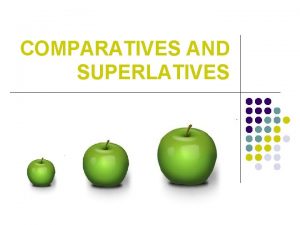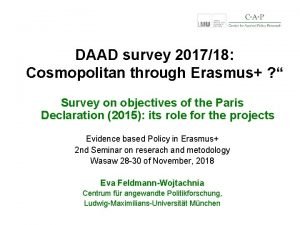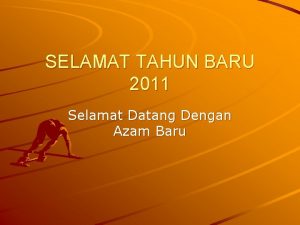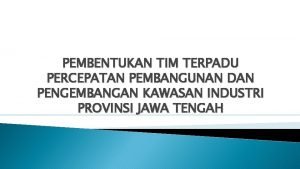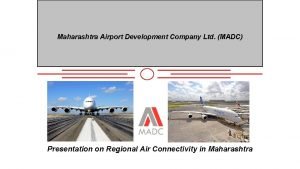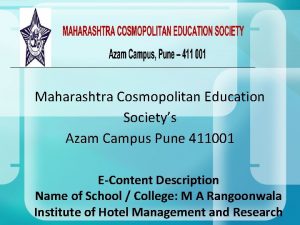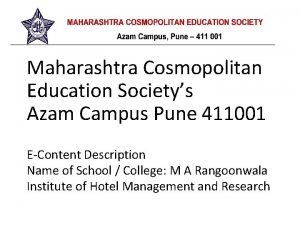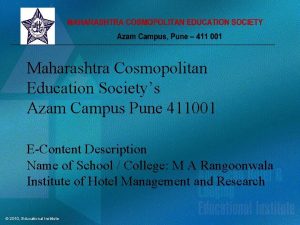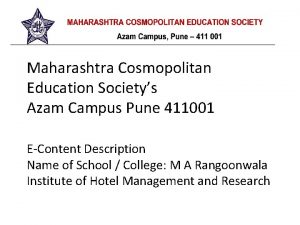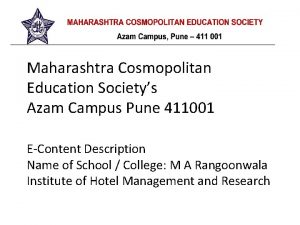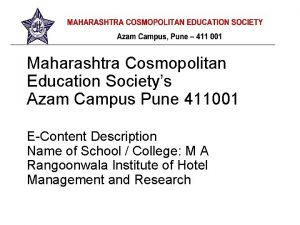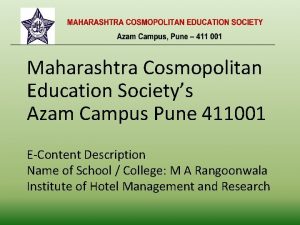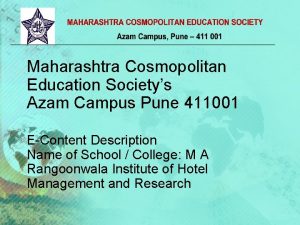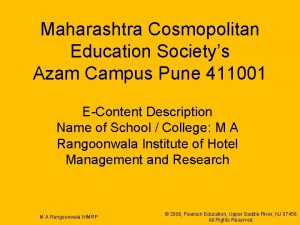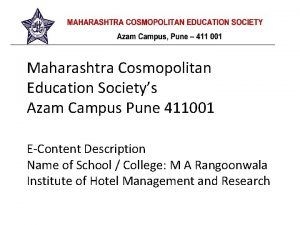Maharashtra Cosmopolitan Education Societys Azam Campus Pune 411001














- Slides: 14

Maharashtra Cosmopolitan Education Society’s Azam Campus Pune 411001 E-Content Description Name of School / College: M A Rangoonwala Institute of Hotel Management and Research

Name and Designation of content creator /Producer Title of E content Theory/practical Title and No of Module Title and code of Paper Assoc. Prof Imran Sayyed Broad Subject Course Class Semester University /Board Date of Content Creation Name of Reviewer HOD/Principal Engineering BSc. HS SY Third SPPU 5 Jan 2020 Imran Sayyed Heat Transfer Theory Heat Transfer The Science of Hotel Engineering Subject Code : HS 206 M A Rangoonwala IHMRP

Heat Transfer • The fundamental modes of heat transfer are: • Conduction or diffusion • The transfer of energy between objects that are in physical contact. Thermal conductivity is the property of a material to conduct heat and evaluated primarily in terms of Fourier's Law for heat conduction. • Convection • The transfer of energy between an object and its environment, due to fluid motion. The average temperature, is a reference for evaluating properties related to convective heat transfer. • Radiation The transfer of energy by the emission of electromagnetic radiation.

Units of heat • The most common units for heat are: • BTU (Btu) - British Thermal Unit - also known as a "heat unit" in United States the amount of heat required to raise the temperature of one pound of water through 1 o. F (58. 5 o. F - 59. 5 o. F) at sea level (30 inches of mercury). • Calorie the kilogram calorie, large calorie, food calorie, Calorie (capital C) or just calorie (lowercase c) is the amount of energy required to raise the temperature of one kilogram of water by one degree Celsius • Joule is a unit of energy equal to the work done when a force of one newton acts through a distance of one meter

Fuels General types of chemical fuels Primary (natural) Solid fuels Liquid fuels Gaseous fuels Secondary (artificial) wood, coal, peat, dung, coke, charcoal etc. petroleum diesel, gasoline, kerose ne, LPG, coal tar, naptha, ethanol natural gas hydrogen, propane, coa l gas, water gas, blast furnace gas, coke oven gas, CNG

Earthing What is Grounding or Earthing? • To connect the metallic (conductive) Parts of an Electric appliance or installations to the earth (ground) is called Earthing or Grounding. • In other words, to connect the metallic parts of electric machinery and devices to the earth plate or earth electrode (which is buried in the moisture earth) through a thick conductor wire (which has very low resistance) for safety purpose is known as Earthing or grounding.

Need of Earthing or Grounding. Why Earthing is Important? • The primary purpose of earthing is to avoid or minimize the danger of electrocution, fire due to earth leakage of current through undesired path and to ensure that the potential of a current carrying conductor does not rise with respect to the earth than its designed insulation. • When the metallic part of electrical appliances (parts that can conduct or allow passage of electric current) comes in contact with a live wire, maybe due to failure of installations or failure in cable insulation, the metal become charged and static charge accumulates on it. If a person touches such a charged metal, the result is a severe shock.

Electrical safety Equipments • • • • Electrical Safety Checklist Within this checklist… • Sockets and Switches • Cords • Lighting • Portable Electric Heaters • Electric Blankets • Large Appliances • Small Appliances • Residual Current Devices • Fuses and Circuit Breakers • Outdoors • Electrical Emergency

Direct Lighting • Lighting provided from a source without reflection from other surfaces. In daylighting, this means that the light has travelled on a straight path from the sky (or the sun) to the point of interest. In electrical lighting it usually describes an installation of ceiling mounted or suspended luminaires with mostly downward light distribution characteristics.

• • • Advantages: Very energy effective lighting. Plastic display of three dimensional objects, eg. sculptures. Well suited for zonal or accent lighting. Can create a vivid environment with attractive light and shadow patterns eg. on wall surfaces. Disadvantages: The ceiling is relatively dark, which can cause a "cave like" environment. Luminaires with wide opening angle that are badly positioned can cause reflected glare on computer screens, dark "executive style" desk surfaces or glossy paper. Harsh shadows can be unflattering when cast on human faces.

Indirect Lighting • Lighting provided by reflection usually from wall or ceiling surfaces. In daylighting, this means that the light coming from the sky or the sun is reflected on a surface of high reflectivity like a wall, a window sill or a special redirecting device. In electrical lighting the luminaires are suspended from the ceiling or wall mounted and distribute light mainly upwards so it gets reflected off the ceiling or the walls.

• Advantages: • Creates a soft, undisturbing environment suitable for concentrated work or viewing paintings or drawings. • Reflective glare on computer monitors can be controlled more easily. • Displays human faces advantageously for social gatherings. • Can be installed without disturbing the ceiling surface (eg. in historical buildings or a painted ceiling). • Disadvantages: • It can be disturbing if the ceiling is the brightest surface in a room. • Makes it difficult to recognise details on three dimensional objects. • There is very little contrast in the room which can be boring. • Not very energy effective.

Types of electric supply (single phase, three phase) • In a single-phase supply, a single alternating current in supplied through a single wire, whereas in a threephase system 3 wires carry alternating current with a definite time offset in between the voltage waves • In India a single-phase supply is a 230 V supply through two wires and 3 -phase supply is 415 V supply through 4 wires and in the house the line can be divided to give 230 V at individual point. The basic difference between the two is that a three-phase connection can handle heavy load while a single-phase cannot.

